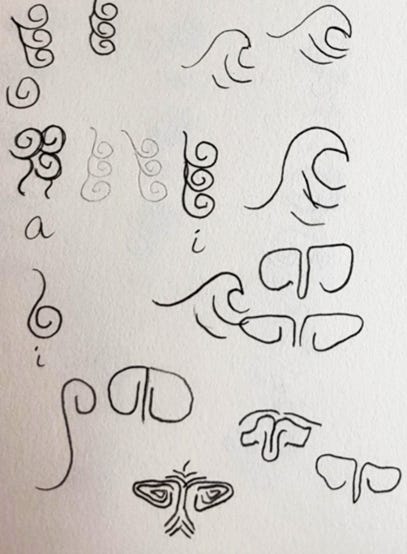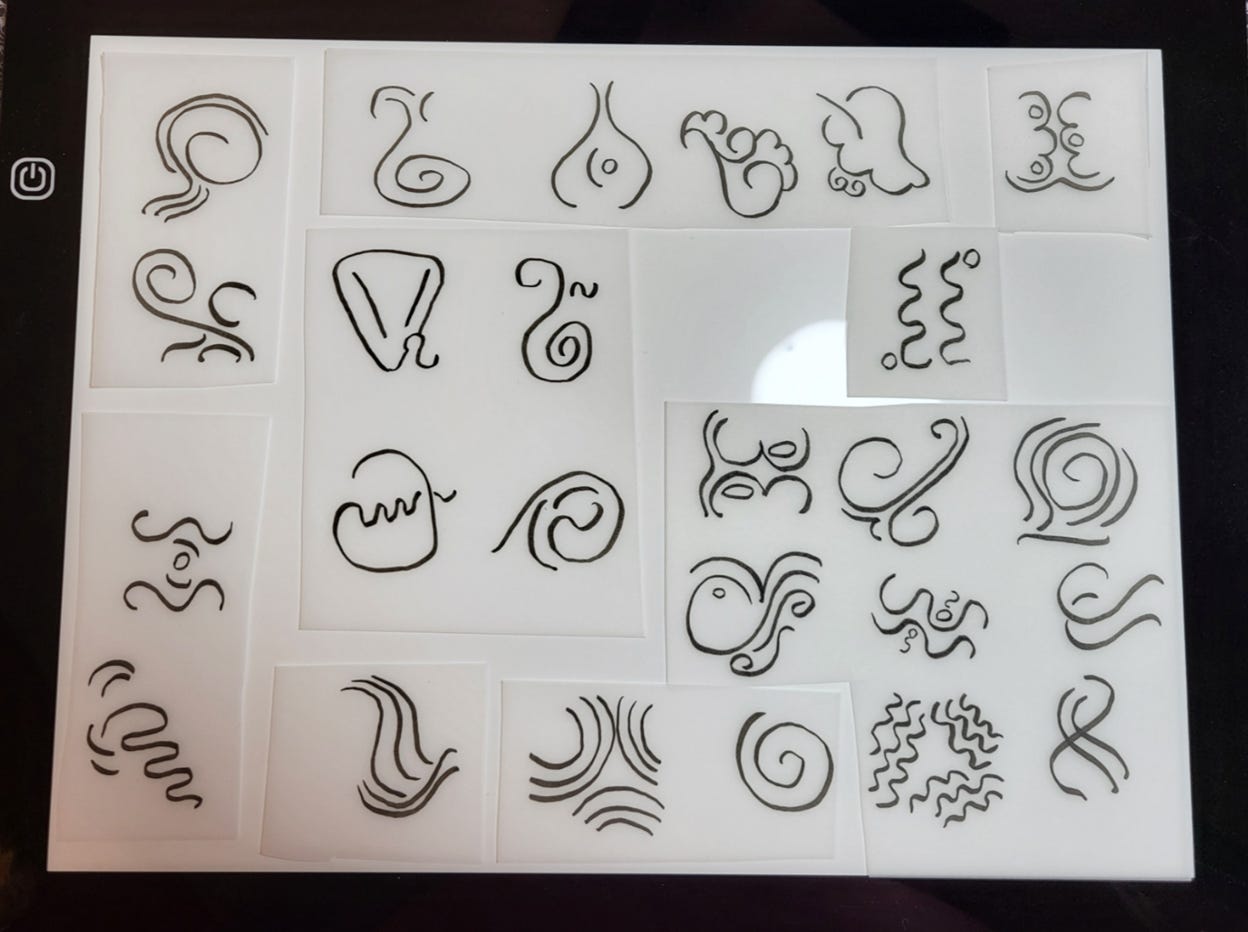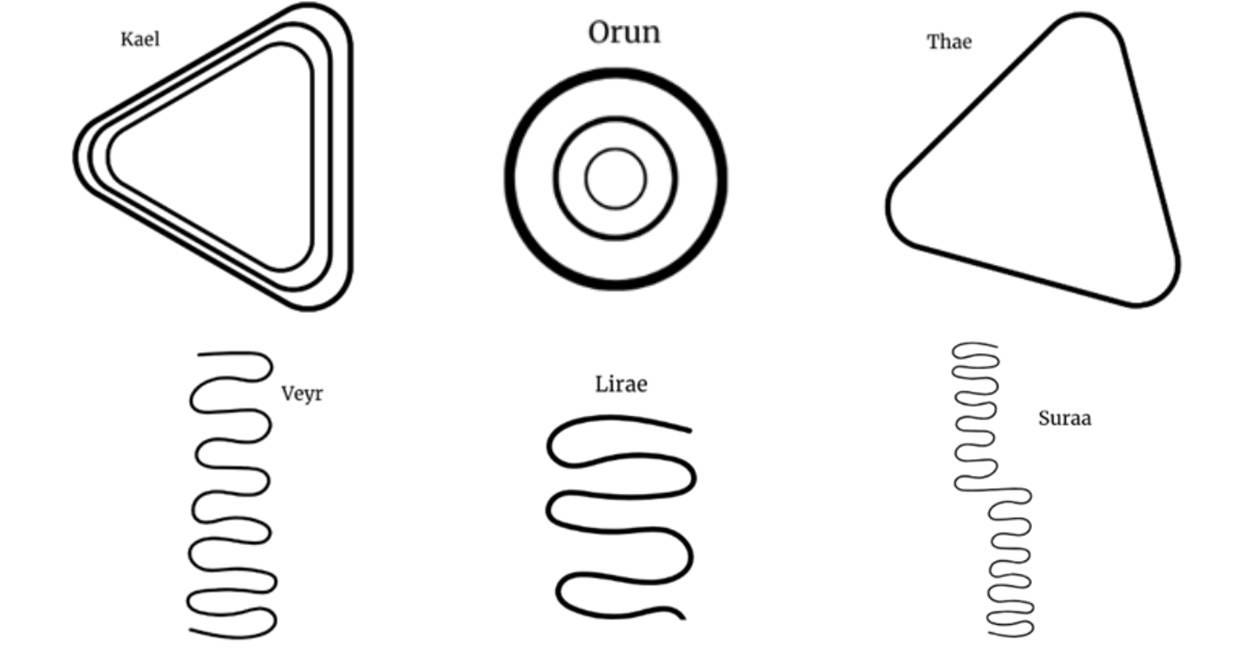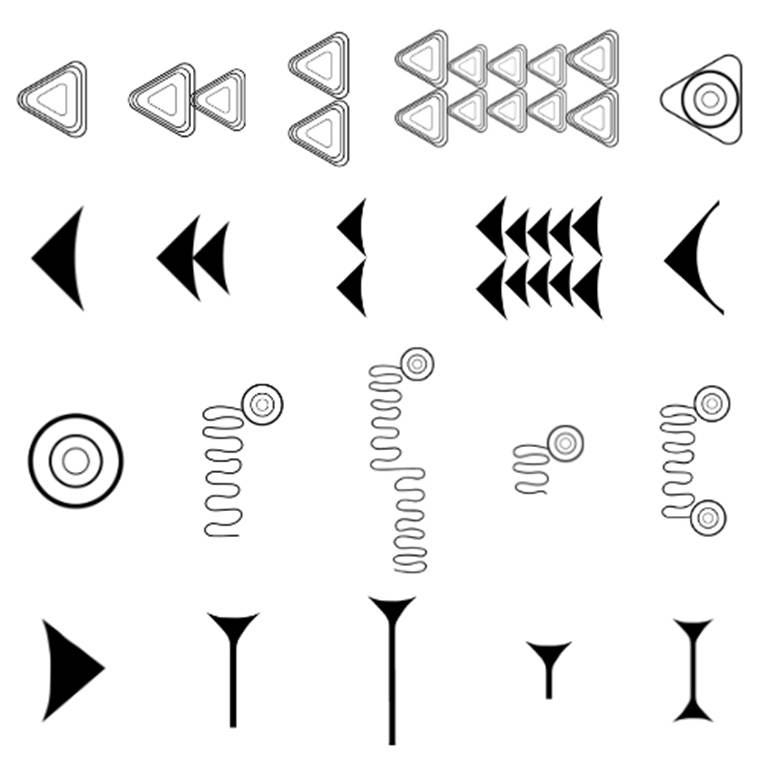Threlraan: The Craft & the Chaos
Essay 8: Crafting the Whale's Tongue
“My notebooks look more like a storm than a system.”
Creating Chaos
Inventing an alien language isn’t a neat, finished project.
If you have been following my initial Whale’s Song series through the current Crafting the Whale’s Tongue, and various notes in between, you will have noticed some of Threlraan’s evolution
For me, the journey began in deciding in what language the aliens would deliver their message. After all, the entire story of World Beyond the Song weaves around, through, and within the protagonist decoding an alien signal.
Follow me, as I share where I began and then arrived at the current state of the still-evolving language of the Biet Lagos—Threlraan.
Even chaos has its scaffolding. Mine began to take shape when I started asking what language the aliens would use to sing their story.
Complex but Logical
In the earliest days, I was thinking “whales in space.” Of course, that led me to learning how whales communicate. And then begat the Whale’s Song series (my debut on Substack).
For reasons that may not become clear until the second book of my planned trilogy, the alien language was always destined to echo back to Earth. It was that realization that led me to understanding our own earliest communication systems, and specifically the earliest formal written communication system of cuneiform. Runes and glyphs have always fascinated me, so cuneiform was a natural curiosity for me to follow.
Akkadian cuneiform may appear simple in its logic, and in its day, it was. However, deciphering that simple logic from the distance of several millennia transforms the ‘language’ to a complexity. And that sounded like something I could use as a foundation for Threlraan … and so it goes.
Besides, the Biet Lagos are an advanced sentient alien species. Things couldn’t be simple … at least not from our human perspectives.
It’s no coincidence that the Biet Lagos are a cetacean-like species, e.g., ‘whales in space’. That was another decision based on personal preferences. I love whales. In fact, I plan to return as one in my next life … assuming the world is a kinder, gentler place.
Cuneiform brought me patterns of syllabic nuances. Whale communication systems brought patterns of clicks and thrums. And overall advances in understanding how non-humans on Earth communicate, from fungi to tomato plants to octopuses, brought me confidence I was on the right track toward inventing an alien language.
Cuneiform, clicks, and bioluminescent pulses are all modes of earthly communication. Since I base my fiction on what we, on Earth, tend to interpret as real, I saw the Biet Lagos form of communication as multi-modal from the beginning—a melody of sorts. A song.
The idea of song, itself, and the theme I strove to relay produced not only the foundation for an alien language, but the title of my favorite work in progress—World Beyond the Song.
What began with a simple but truly complex logic transformed. Slowly at first, quickly at times, but still continues.
“… worldbuilding is less about imposing order than following resonance …”
Transformation
I could never draw (I was told so), but I could doodle. My notebooks look like a storm more than a system. But I knew what I intended.
From the start, the glyphs had to swirl, evoking oceanic motion.
Below are some of my very first swirling doodles.
As I became more comfortable with swirls, I committed to an early lettering system. I say ‘early’, but my original thought was more like, “Okay, this is it.” My commitment stemmed primarily from my lack of confidence even in doodling. (Go figure.)
The following became my rudimentary alphabet/syllabary:
Thankfully, early on I realized if I was going to draw these symbols or glyphs by hand, I needed to make them all to the same scale. So, I outlined uniform-sized boxes and redrew the glyphs within those confines.
My next step was to scan the individual glyphs, with the idea of creating a ‘typeable’ set of ‘letters’. I had learned of various programs, like FontForge, and Calligraphr, which sound easy enough to use—when I get to that stage. But for now, I retraced all my glyphs onto tracing paper with a heavier microline pen and scanned them for posterity. (Note the evolution of glyphs.)
Although the process so far had been time-consuming, I hadn’t gotten that far before I realized two things: (1) the highly advanced civilization of the Biet Lagos would not ‘hand-write’ their written language, and (2) I needed my glyphs to mimic cuneiform more precisely—something more conducive to overlaying auditory components and sequences of bioluminescent light pulses.
This was an important realization, and not one spurred by making it easier for Jayla to decipher, but rather to better represent the logic of this complex, multi-modal language more coherently. Thus came ‘threls.’ And newly deliberate attention.
Threls are the individual components that combine to make a glyph. As I looked more closely at cuneiform glyphs used in Akkadian, I identified six signature components—called ‘threls’—and gave them Threlraan names and a new look:
In the figure below, you will see how the above threls combine to form an individual glyph, followed by an image of how Threlraan glyphs combine to form a word. Note that the solid black symbols represent the various wedge marks of cuneiform, and above each is its Threlraan counterpart.
What I am not able to show you just yet is how the Threlraan glyphs contain additional information, e.g., the afore mentioned audio clues and the pulsing light sequences. It will take a little more honing of my modest skills to create a ‘living’ Threlraan glyph, or the actual message Jayla receives on Talamh Ru.
As I said earlier, inventing language is messy—fluid, and evolution is bound to continue. But doodles only go so far before they demand structure. And structure brings its own kind of chaos.
What’s Solid, What’s Still Fluid
The threls, or the alphabet strokes are solid (relative to the larger picture), as is the biological basis for the language (e.g., the thuln and bioluminescence.)
What remains fluid are the glyph variants, the ritual versus casual registers, the grammar rules—and a few revelations yet to surface.
The greatest challenge I face at the moment is aligning the audible elements with the ‘written’ elements. Some options I am considering are aligning beats or clicks with certain shapes in a glyph.
For instance, a stacked wedge might indicate a double soft click with an amber bioluminescent pulse duration of 0.5 seconds. A circular shape emits a repeating sharp click and a cyan light flashes for a 0.3 second duration, chasing itself around and around.
Do I really need to work it out in this kind of detail? The short answer might be: “Maybe not.” My heartfelt answer is another question: If not, how can I count on a truth that is vital to Jayla, our protagonist, solving the mystery without providing a truth?
Challenging? Yes. Chaotic? Certainly. Meaningful? Must be. At least that’s how I see it … someone has to embrace the chaos.
Embracing Chaos
It never occurred to me to mimic or understand languages constructed for other works of fiction, but retrospectively, I doubt I would have done anything different.
I’ve recently added to my collection a book edited by @Dimitri Fimi and Andrew Higgns—A Secret Vice: Tolkien on Invented Languages by J.R.R. Tolkien. I have not read it yet, but I am getting ready to. I am now comfortable enough in what I am creating with Threlraan that I can look at how others have invented alien or fantastical languages.
Some might argue it would have been more helpful to read ahead of time—to avoid some of the chaos. But I wanted my process to be … my process. For the same reason that I do not read fiction while I am creating my own fiction.
I realize there is much insight to gain in reading Left Hand of Darkness by Ursula Le Guin, for example, but I want to hear my own ideas first. Of course, someone else has already had those ideas. Still I want to experience them from my own naivete first. It’s bad enough that I curse Star Trek for ‘stealing’ my tardigrade and micro-wormhole ideas.
Yes, not being better read and choosing not to read more while I write makes my own discoveries and creations a little more messy, but how else will I embrace my inner thoughts without also embracing the chaos?
For me, worldbuilding is less about imposing order than following resonance. I am not sure Threlraan, or the Biet Lagos would have ever emerged otherwise.
Sorting through the mess is a creative outlet for me. Sharing the mess is my way of getting to know my readers better.
Why Share the Mess
On Substack alone, I have encountered humbling creativity and writing. It almost intimidates me. Almost. More so, it makes me feel honored to participate.
I have shared this process, my process, for inventing a language with you, because I like sharing. It helps me evolve as a writer … as a human. Maybe you find something useful to your own needs in reading about my process. Maybe you shrug and say, “Why? Why does JL do this—go to these lengths?”
Because it’s another opportunity for me to view my own lovable mess. I let you get to know me a little better, and I get to know myself a little better. And maybe someday, we all sit around a camp, not to sing Kum Ba Yah—although that would be fine too—but to share stories.
Wouldn’t that be a fine ‘mess’?
Closing Reflection — The Beauty of Incomplete
I liked my original concept of Threlraan; I still do. I’ve written my son’s names in the original glyphs, just because … I loved it!
But evolution happens.
That’s the beauty of craft: the chaos never truly ends. It just sings in new keys.
Threlraan is not finished because the Biet Lagos are not finished — and neither am I.
In the final essay of this Crafting the Whale’s Tongue, we’ll return to the story itself — how Threlraan becomes a character in World Beyond the Song.














As I have watched Threlraan develop over time, I did so with awe and the idea that I would never do something like this. The complexity of simple doodles. Wow! ( I am sure you have seen this from Wikipedia: https://en.wikipedia.org/wiki/List_of_constructed_languages )
Deciphering the language of the Biet Lagos is a major part of your story. You are in great company; Tolkien is but one. Off the top of my pea brain: Vulcan, Romulan, and Klingon from Star Trek. The list goes on. Even those examples are not as complex as Threlraan.
Certainly, I'll never need to develop such a language. That is until my story sent two people to the far side of the galaxy, and they can't understand or read anything. Maintaining the Star Trek analogy, you HAVE gone where very few have gone before. Gratz!
I've loved hearing about your process--it's fascinating! Also, I think it's wonderful that you're following your curiosity into these dark and messy places. Maybe it's not the way others would do it, but that's exactly what makes it YOURS. ❤️